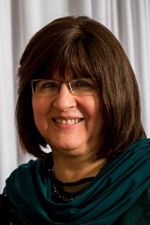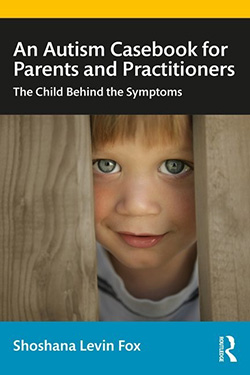An Autism Casebook for Parents and Practitioners: The Child Behind the Symptoms by Dr. Shoshana Levin Fox
By Toby Klein Greenwald

 EFRAT, Israel –Dr. Shoshana Levin Fox has authored a book that will hold you spellbound. Section I is titled “Children.” These first eight chapters are the stories of Jack, Sasha, Annie and others (all the children’s names used are pseudonyms) – children who came into the Feuerstein Institute after having been diagnosed as autistic. They exited with new hope, not only for themselves, but for their parents, who were usually devastated by their children’s diagnoses and needed their own emotional propping up.
EFRAT, Israel –Dr. Shoshana Levin Fox has authored a book that will hold you spellbound. Section I is titled “Children.” These first eight chapters are the stories of Jack, Sasha, Annie and others (all the children’s names used are pseudonyms) – children who came into the Feuerstein Institute after having been diagnosed as autistic. They exited with new hope, not only for themselves, but for their parents, who were usually devastated by their children’s diagnoses and needed their own emotional propping up.
The central theme of this book is that autism is grossly over-diagnosed. Levin Fox is a psychologist and play therapist who has worked with children for more than 30 years. In addition to lecturing and giving workshops in North America, Israel and Europe, she worked for 25 years in the prestigious Feuerstein Institute of Jerusalem, founded by the late Sorbonne-educated Professor Reuven Feuerstein, and before that in Vancouver, Canada. Her doctorate is in Counseling Psychology, with a specialty in Play Therapy, from the University of British Columbia.
I warmly recommend the book, not just for the moving stories of the children who were salvaged from what proved to be inaccurate assessments, and not only for the intriguing descriptions of the practices of the world-renowned Feuerstein Institute, which Dr. Levin Fox combined with the wonders of the DIRFloortime method. This book should be read for its critical message to parents who have received an autism diagnosis for their son or daughter: Believe in your child. Talk to your child. Keep looking till you find her the best and most appropriate help and hope. Don’t let the “experts” get you down, because a true expert will find the formula to lift you – and your child – up.
Most importantly, do not assume that an expert who gave you an assessment of autism, that may feel like an emotional-cognitive death sentence, is right, and even if the assessment is accurate, and the child is truly autistic, that does not mean there is no hope.
This book is not only for parents of children with autistic symptoms; there is a message here for all parents: Even when there is a diagnosis of less daunting conditions — such as learning disabilities, ADHD, or other emotional, cognitive or developmental challenges — keep shopping till you find the professional who will light the way through the tunnel.
The idea of plasticity of the brain, writes Levin Fox, entered mainstream medicine several generations after the Professor had intuited and created materials and methods based on that reality. “There were no sacred cows for the Professor,” she writes, and decries the fact that “the diagnosis of autism is used as a sacrosanct truism…I have found that the term ‘autism,’ as it appears commonly in the field, in actuality is being used to describe children who suffer from a vast range of communication difficulties, from extreme shyness to psychotic conditions and just about everything in between.”
It is not clear to her how research studies can be reliable, writes Levin Fox, “with the current diagnostic criteria of autism so elastic and with the use of the term so liberal.”
The children whose stories are recounted in this book all made significant, even dramatic, progress. Levin Fox writes that, “Not every child began to speak fluently, to learn at a normative level and to play happily with friends…However, it can be safely and honestly stated that, inspired and mentored by the Professor, my colleagues and I made a huge difference in the lives of hundreds of children originally thought to be autistic.” She sees them, as a team, as having saved many lives.
Feuerstein sought to find the child’s latent strengths, and what he called “islets of normalcy.” She explains how “islets of normalcy” are identified and worked with. They include, among other elements, eye contact, human relationships, symbolic play, curiosity, humor and more. “The notion of islets of normalcy helps both parent and practitioner recognize the non-symptomatic behavior [of autism symptoms], the sparks of life and the glimmers of normative functioning within a child’s autistiform presentation.”
There was five-year-old Jack, whose parents came to the Institute and Levin Fox discovered in him an engaging child with a rich imagination. His parents told her that, as he had verbal communication problems, they had taken him to be tested and had been told he was autistic.
Levin Fox emphasizes that helping the parents to understand their children’s challenges, and not to be fearful and depressed about them, is part of the battle.
At the Institute Jack thrived, and left the early diagnosis of autism far behind. The details of the process are in a fascinating ten-page chapter.
She writes about a little girl, Annie, who clearly had developmental difficulties, but, “Each of a child’s tangible, visible symptoms is a world in itself. Like the shoots of a green plant, symptoms have intricate roots.”
Levin Fox gave the parents tools to work with their daughter and continued to follow her progress. When she met her again at the age of six, she wrote, “The sweet, charming, warm, open and communicative child…bore no trace of the detached, imploded, silent, starving two-and-a-half-year-old of years ago.”
Then there was Davie, who had “a longer journey,” and teenaged Joe, who did not make progress to the same extent as some of the other children, but who years later was a happy, functioning adult living in a group setting with other mildly impaired adults. And Mikey, who began to improve significantly when his parents began to talk to him. He still had a long way to go, but Levin Fox writes, “I learned never to give up on a parent.”
There was Max, who had oral dyspraxia, and his lack of speech had been “misunderstood as an autistic avoidance of speech…his story…dramatically illustrates the tragedy of this kind of misdiagnosis.” She cautions that children’s hearing should always be tested; sometimes the non-responsive child is discovered to be simply hearing-impaired.
In Part II, “Theoretical Groundings,” Levin Fox gives the intense and thorough theoretical background to the success stories, which are plentiful. Six more case studies are interwoven in the text to help bring the theory alive.
This section also describes the fascinating roots of Feuerstein’s methods. He began by working with orphan children who had been traumatized after WWII, decided there were flaws in the standard diagnostic tests, and rather than focusing on performance, he focused on the child’s ability to develop learning processes.
“Current studies on brain plasticity…scientifically substantiates what [Feuerstein] proposed two generations ago – that brain cells are modifiable and respond to the stimuli of the environment.” She writes that for Feuerstein it was an “I told you so” moment.
“He understood that human beings can change…when the environment anticipates and promotes such change.” The children mentioned earlier “markedly diminished their autistic-like symptoms…We believed that the potential was there. We sought it. And when we could not see it, we worked hard to elicit it, and even to create new facts on the ground.” The staff saw themselves as warmly interactive mediators.
One of my favorite stories appears in Chapter 15, “A Paradigm Shift,” where Levin Fox describes in great detail the captivating case history of Ben, whom she first met when he was five-years-old. The end of the chapter, with the sub-heading, “Ben’s Epilogue,” describes a chance meeting between Levin Fox and Ben’s parents, many years later, at the luggage carousal in the arrival area of the airport. “Dr. Shoshana!” they called out, and his mother pulled out her cellphone. “The happy faces of Ben and his wife, holding their newborn son, smiled back at me,” writes Levin Fox. “For Ben, the paradigm-shift had indeed been life-saving.”
I found other words to describe the journeys and the miracles of the children portrayed in this book: life-affirming.
And hope.
*
Toby Klein Greenwald is a journalist, playwright, poet, teacher, and the artistic director of a number of theater companies. She is the recent recipient of the Lifetime Achievement award from Atara-The Association for Torah and the Arts for her “dedication and contributions in creative education, journalism, theatre and the performing arts worldwide.” She also is the editor-in-chief of WholeFamily.com, and was the 2018 recipient of an AJPA Simon Rockower Award for Excellence in Jewish Journalism.